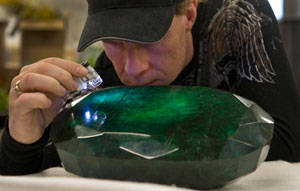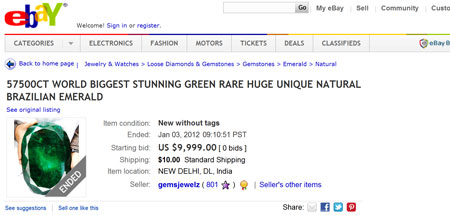BIG Emerald
An emerald the size of a watermelon went on auction January 28. It weighed 57,500 carats, or about 25 pounds. Publicizing it as the “world’s largest cut emerald,” the auction house expected it to sell for at least $1.5 million.
 That didn’t happen. In fact, there were no bids at all.
That didn’t happen. In fact, there were no bids at all.
Although you’ll never be dealing with a gem of such size, this green giant has lessons that are relevant to all gems, all sizes, and all agents & insurers.
Size makes a big impression
News of the impending auction made its way to a number of websites, blogs and video sites. The gem’s size was the attraction—big as a watermelon?? What would one do with such a large stone? The auction house was counting on someone wanting it just because it was the biggest ever.
One internet reader commented innocently, “How is a 57,000-carat stone, largest in the world, worth only $1.15 million? I would think such an enormous gem would be worth more.”
Seems like a good question, but gemologists immediately wondered about the stone’s other qualities. As Antoinette Matlins remarked, “Just because it is large doesn’t mean it’s a 'gem.’”
The color of a colored gem
The emerald was mined in Brazil, cut in India, and brought to the Canada by a gem wholesaler. A gemologist who examined the stone in Canada described it as “forest green,” saying it was natural but “slightly treated.”
Apparently that “slightly” was an understatement, for he later said he was “not sure how much of it is emerald”! It turns out that at least part of the stone started out as white beryl that was subsequently dyed to achieve its vivid green color.
White beryl is fairly common and of little value. Emerald is the name given to beryl that is naturally green. The richness of the coloration, its tone, saturation and hue, account for most of an emerald’s value. If beryl is not green in its natural state, it isn’t emerald.
One GIA gemologist said that the presence of dye would probably lead the GIA to describe the stone as “beryl with zones of emerald,” rather than emerald.
Clarity comes at a price
“I wish it were translucent—then it would be a billion-dollar stone,” said Jeff Nechka, the gemologist who appraised the stone. Wishful thinking doesn’t make a stone a gem. Good quality emerald is transparent, lesser quality emerald is translucent. This giant, dyed green stone was almost opaque.
Emerald is by nature a highly included material. The more inclusions, the lower the emerald’s value. This stone has such severe inclusions and surface-reaching fractures that they are visible even in photographs.
What is it worth?
Ultimately, it is the market that assigns value to a gem. Every day gems are sold that are heavily included and color enhanced. Buyers will sacrifice quality to fit their pocketbook, but they have to want the piece in the first place. What someone is willing to pay, what the piece can actually sell for, is what it’s worth.
This huge stone was offered on eBay for $10,000, but even at that price it failed to draw any bids.
A dramatic close to the story is that the dealer who put the stone up for auction was subsequently arrested for fraud in Canada. His detention was not related to this gem, but he was accused of multiple fraud offenses and had several outstanding warrants for his arrest. This big emerald may have been a fraud, but at least no one was buying.
FOR AGENTS & UNDERWRITERS
What’s true for a big stone is true for a small one:
- Colored stones derive much of their value from their color, and color-treated stones are worth a lot less than untreated ones.
- The fewer inclusions, the greater the value. Clarity treatments may mask inclusions but they lower the stone’s value.
- Purchase price is a good indication of value.
Be sure the appraisal states what treatments have been performed on the stone, or explicitly states that the stone is untreated. Untreated emeralds are worth considerably more than treated emeralds.
A JISO 78/79 appraisal, the insurance industry’s standard for detail and accuracy, carries this essential information.
Not every jeweler, nor even every trained gemologist, is competent to appraise colored gems. A reliable appraiser of emerald is a jeweler/appraiser experienced in dealing with colored gems.
The appraiser should be a trained gemologist (GG or equivalent), preferably one who has additional insurance appraisal training. One course offering such additional training is the Certified Insurance Appraiser™ (CIA) course of the Jewelry Insurance Appraisal Institute in Oakland, CA.
FOR ADJUSTERS
Be sure to compare the valuation with the sales receipt, if it is available. If there’s a wide discrepancy between price and valuation, the selling price is generally a more accurate indication of value.
If the purchase price seems unusually low for the stated valuation, this may mean that the gem has undisclosed treatments or that it is lab-grown.
For damage claims on high-value jewelry, ALWAYS have the jewelry examined in a gem lab by a trained gemologist. Such an exam:
- will identify the gem;
- will verify the quality of the jewelry;
- may supply information missing from the appraisal;
- may reveal that the "damage" is not damage at all;
- may show the damage resulted from breakdown of fracture-fill material.
The appraiser examining colored stone jewelry should be a trained gemologist (GG or equivalent), experienced in dealing with colored stones, preferably an appraiser with additional insurance appraisal training. One course offering such additional training is the Certified Insurance Appraiser™ (CIA) course of the Jewelry Insurance Appraisal Institute in Oakland, CA.
©2000-2025, JCRS Inland Marine Solutions, Inc. All Rights Reserved. www.jcrs.com


